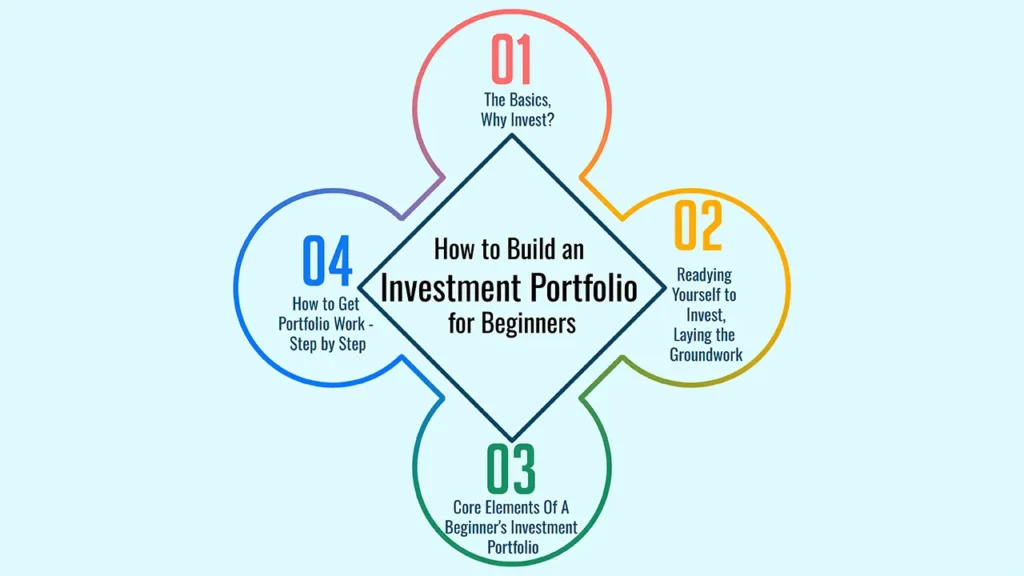Starting to invest can be troubling, particularly if you’re new to the world of stocks, bonds, and funds. The good news is that building a solid investment portfolio is not as difficult as it might seem. Whether you’re putting money away for retirement, purchasing a home, or just building wealth over time, a thoughtful investment portfolio that’s constructed with your goals in mind can make all the difference.
For starters, when you lay a solid foundation by focusing on the fundamentals and taking deliberate, measured steps, you’re setting up your financial plan to succeed for years to come. This article will guide you on how to build an Investment Portfolio for beginners step by step. You need to apply before you can put together an investment that suits your lifestyle and risk tolerance level.
Once you’ve grasped how to spread risk and return, how to avoid scams and costly mistakes, and how to choose the best accounts and funds, you will find investing in the stock market interesting and fun.

Section 1: The Basics – Why Invest?
What’s an Investment Portfolio and Why Do You Need One?
An investment portfolio is a set of financial investments held by an individual or by an institution. It is usually made up of a mix of assets, including stocks, bonds, and other securities.
Importance:
- Fight Inflation: Investing allows your money to grow faster than inflation.
- Build Wealth Over Time: A well-designed investment portfolio has the potential to alter your life and generate significant wealth over time.
- Meet Financial Objectives: From saving for retirement to a down payment on a home to funding a college education, an investment portfolio is one way to meet your financial goals.
- Benefits of Diversification: By investing in a variety of asset classes, you reduce your risk.
Makes Sense Investing Tips for the New Investors
- Risk vs. Return: The basic concept – that higher potential returns always mean higher potential risk.
- Diversification: It is important not to have all of your eggs in one basket; this is crucial for risk management.
- Compounding: The miracle of compounding interest makes a big difference in your wealth over time.
- Time Horizon: How long you plan to invest will impact your investment selections and risk level.
Section 2: Readying Yourself to Invest – Laying the Groundwork
Assess Your Financial Health
- Create an emergency fund: Do not get into investing without having an emergency fund first. You should have: 3 to 6 months of living expenses saved (no negotiation).
- High-Interest Debt: Focus on repaying high-interest debt that can thwart your ability to invest profitably.
- Budget: Know your income and outgo, so you can figure out what you can invest.
Establish Your Investment Objectives and Tolerance for Risk
- Concrete goals: Figure out exactly what you’re investing for (for example, retirement in 30 years or a home in 5 years).
- Time horizon: Connect your goals to set timeframes so you can shape your investment strategy accordingly.
- Risk Tolerance Test/Quiz: Be honest about your risk tolerance. Think about including a simple quiz to determine risk tolerance, or linking to a trusted one.
Section 3: Core Elements Of A Beginner’s Investment Portfolio
Stocks: When You Own Part of a Company
- What they are: Stocks are stakes in a company that can rise or fall along with the company’s fortunes, and that pay dividends.
- Pros: High growth potential over time.
- Cons: More volatility and risk than some other asset classes.
Beginner-friendly options:
- Index Funds: Which track a market index, such as the S&P 500.
- ETFs (Exchange Traded Funds): These funds allow broad diversification and can be bought and sold like stocks.
Bonds: Investing for Returns by Lending Money
- What they are: Bonds are debt securities in which you lend money to an issuer in exchange for regular interest payments and the repayment of the bond’s face value when it matures.
- Pros: Typically lower risk and offer income generation.
- Cons: Lower returns than stocks; interest rate risk.
Beginner-friendly options:
- Bond ETFs: These funds provide exposure to and invest in a broad portfolio of bonds.
- Government Bonds: Considered safe investments.
Other Diversification Assets (Briefly Mentioned)
- Real Estate (REITs): You don’t directly own any properties, but you can still invest in real estate through REITs.
- Commodities: Such as gold, for further diversification (emphasize this is for later stages).
- Cash Equivalents: Maintain liquidity for emergencies and short-term needs..
Step 5: How to Get Portfolio Work – Step by Step
Select the Appropriate Investment Account
- Brokerage accounts: For “general” investing – in other words, that doesn’t involve a specific goal (such as retirement, a home purchase, etc.), where you buy and sell various securities. Learn about opening a brokerage account from SmartAsset’s guide.
- Retirement Accounts (IRAs, 401(k)s): Highlight the tax advantages of these accounts for long-term savings.
- Robo-Advisors: Ideal for beginners, robo-advisors will automatically manage your investments for very low fees. They usually come with features such as automatic rebalancing.
Set Your Asset Allocation
- Rules of Thumb by Age: for instance, the rule of 110 or 120 minus your age to decide how much should be in stocks.
- Risk Tolerance: More conservative investors might want to add more to bonds, while more aggressive investors may also prefer stocks.
Sample Portfolios for Different Risk Profiles:
- Conservative: 60 percent bonds, 40 percent stocks.
- Moderate: 60% stocks, 40% bonds.
- Aggressive: 80 percent stocks, 20 percent bonds.
Pick and Choose Investments (Focus on Funds for Beginners)
- Index Fund/ETF Solutions: Re-highlight the value of them for diversification and ease.
- Dollar-Cost Averaging: Describe how to invest a set amount of money regularly, irrespective of market prices, and how it cushions the effects of volatility.
Keep a Pulse on Your Portfolio and Rebalancing
- Why Monitor: You want to monitor your portfolio periodically to make sure it matches your goals.
- Rebalancing Definition: Bringing your asset allocation back to a desired risk level based on market symmetry.
- How Often: Annually, or whenever your allocation falls significantly out of whack with your targets.
Section 5: Some Common Mistakes Beginners Make & How to Do Them the Right Way
Traps to Dodge on Your Investment Path
- Emotional Investing: Don’t sell or buy into market hype out of fear or anxiety.
- Not Diversifying Enough: Having all your eggs in one basket raises the risk factor.
- Hunting: Hot Stocks: Invest for the Long Run, Not the Short Term.
- Overlooking Fees: Excessive fees can eat away at your investment returns over the years.
- Not investing regularly: Failure to dollar-cost average may stunt growth.
- Starting Too Late: Compounding’s magic works best for those who invest early.
Conclusion: Personally Construct Your Future Today
Starting to construct your first investment portfolio is a great way to set yourself up for a more secure financial future. It might seem daunting at the outset, but having a clear plan based on diversification, risk perception, and regular contributions will benefit you in the future.
Remember that investing is not about quick wins or market timing but steady growth and keeping the faith with your personal goals. Begin early, and you can score the magical effects of compounding, which means even small contributions end up as significant sums of wealth.
And, most importantly, continue learning and adapting your portfolio as your situation and goals change. With some fundamental base knowledge and the right mindset, your beginner investment portfolio will be a cornerstone in your confidence and wealth as you navigate your financial life.
FAQs
1. What is an investment portfolio?
Portfolio An investment portfolio is the sum total of an investor’s investments in particular companies, as well as other investments in the same kind of market.
2. Why is diversification so important?
Diversification applies because you’re spreading your eggs across a variety of baskets, which can help mitigate the pain of poor performance in any one investment.
3. How do I know what my risk tolerance is?
They can also measure your risk tolerance with a quiz or an assessment on your tolerance for market swings or potential losses.
4. What are index funds and ETFs?
Index funds and exchanged-traded funds (ETFs) are investment funds that follow a market index, giving you diversification and lower fees than funds that are actively managed.
5. What is the frequency of rebalancing my portfolio?
Rebalancing is usually done on an annual basis, or as specific asset classes stray far from your target percentages.

Leave a Reply